Temple treasures of Tamil Nadu
A combination of architectural brilliance, intricate rituals and pageantry attracts millions of devotees and tourists to the quaint temple towns of Tamil Nadu
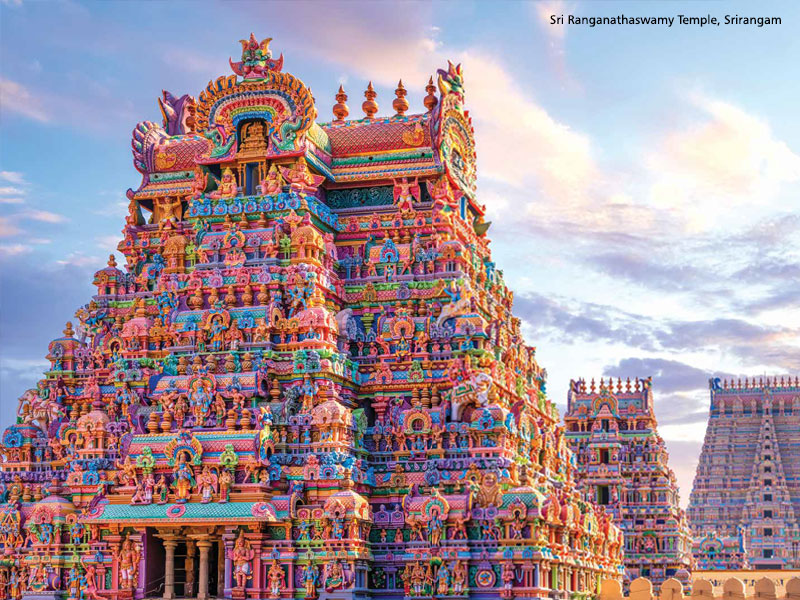
A precious and revered legacy of the southern state of Tamil Nadu (pop: 67 million) are its magnificent temples, monuments of exquisite architecture and art forms evolved over several centuries. Most of them are over a millennium old and faithful custodians have religiously preserved their colourful festivals, elaborate worship protocol and devotional music and dance traditions. This combination of architectural brilliance, ancient rituals and pageantry attracts millions of pious devotees and a growing number of tourists to the temple towns of Tamil Nadu. Last year the state hosted over 38 million domestic and 607,300 foreign tourists, most of whom included the state’s temple sites on their itineraries.
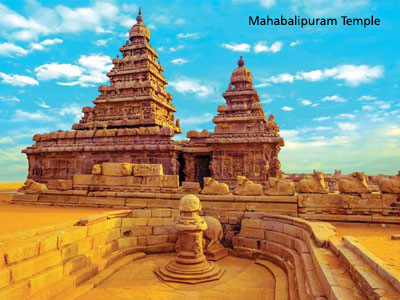 The history of Tamil Nadu’s temples is intrinsically linked with the history of the state, which prides itself for its 5,000-year-old Dravidian civilisation and culture, dating back to the 4th century B.C. Tall gopurams (gateways) with ornately sculpted towers that pierce the skies of Tamil Nadu (‘land of the Tamil people’) are testimony to the architectural and artistic creativity of successive dynasties that ruled here. The Chola, Pandya and Chera dynasties which reigned in 300 BCE during the classical period of Tamil literature — the Sangam age — which continued until 300 AD, were dedicated temple builders and their patronage of the arts facilitated the expansion of Dravidian culture.
The history of Tamil Nadu’s temples is intrinsically linked with the history of the state, which prides itself for its 5,000-year-old Dravidian civilisation and culture, dating back to the 4th century B.C. Tall gopurams (gateways) with ornately sculpted towers that pierce the skies of Tamil Nadu (‘land of the Tamil people’) are testimony to the architectural and artistic creativity of successive dynasties that ruled here. The Chola, Pandya and Chera dynasties which reigned in 300 BCE during the classical period of Tamil literature — the Sangam age — which continued until 300 AD, were dedicated temple builders and their patronage of the arts facilitated the expansion of Dravidian culture.
During the second half of the 4th century when the Pallavas rose to power, Dravidian architecture attained its apogee. The splendid temples of Mamallapuram, the Kailasanathar temple at Kanchipuram (which hosts 1,000 shrines) and the Kapaleeshwarar temple in Chennai proclaim the architectural ingenuity of Pallava dynasty architects.
The varied styles and building materials which distinguish the temples built by ancient dynasties of Tamil Nadu are highly educative for students of architecture. The most ancient were built of brick and mortar. Subsequently circa 700 AD, temples were scooped out of caves by Pallava and Pandya architects. The Pallava kings (upto 900 AD) were also great builders of stone and rock temples. The Cholas (900- 1250 AD) made significant changes in structural styles, by adding ornate mandapams (dolmens) and halls and constructed impressive gopurams (gateways). The Pandya era (up to 1350 AD) witnessed the emergence of huge towers, high wall enclosures and towering gateways. The Vijayanagar rulers (1350-1560) built taller gopurams and installed sculpted monolithic pillars as evidenced in some of the most visited temples — Srirangam and Chidambaram. The Naiks (1600- 1750) added large prakarams (circumambulatory paths) and pillared halls, enhancing the spatial elegance of temples.
Apart from the grand design and layout that attract history and architecture enthusiasts from around the world, the
puranic legends and religious rituals associated with TN’s temples lure streams of domestic tourists to experience their magic and mysticism. “Their serene, spiritual ambience instills peace. Moreover the elaborate pooja rituals and annual festivals draw huge crowds willing to brave the ordeal of standing in serpentine queues to get a glimpse of presiding deities, in the belief that their prayers will be answered,” says K. Seshadrinathan, former professor, department of management studies, University of Madras, who has written extensively on Indian temples.
An estimated 265 of the 275 shivasthalams (abodes of Lord Shiva, the supreme manifestation of divinity in the Saivite tradition) and 84 of the 108 divya desams (celestial abodes of Lord Vishnu, the supreme manifestation of the Vaishnavite tradition) are in Tamil Nadu. Some of them are small shrines, others desolate and neglected, while the well-endowed temples are lively centres of art, culture and worship. Temples of the last group are profiled here.
Sri Ranganathaswamy temple, Srirangam
Sited a mere seven km from Thiruchirappalli aka Trichy, and bounded by the river Kaveri on one side and its tributary Kollidam on the other, Srirangam is an island town spreadover 600 acres within the seven walls of the majestic Sri Ranganathaswamy temple. The most famous of the 108 temples of Lord Vishnu, Srirangam is a revered pilgrimage centre of Vaishnavites.
Temple life evolved in Srirangam after the poet composer Nadamuni (923-1023) compiled hymns eulogising Alwar saints of the first millennium and set them to music. Before the birth of Ramanujacharya (12th century), the beacon of the Vaishnava tradition, the Ranganathaswamy temple was a well-established institution. From the 13th century onwards, the Cholas, followed by the Pandya rulers, endowed the temple with its gold-plated vimanam (tower crowning the innermost sanctum) and the Hoysala kings added further embellishments.
Today, Sri Ranganathaswamy temple is among the grandest in India, depicting the architectural history of several eras. Distinguished by its 21 gopurams including the 245 ft high, 13-tiered rajagopuram built recently in 1987, the temple enshrines Lord Ranganathar in the central sanctum (garbagriha) in a reclining posture, crowned with a gold plated pranavavimanam (tower). The festival deity, Nam Perumaal is also housed in this sanctum, surrounded by seven concentric prakarams, and dotted with mandapams, tanks and shrines. The majestic 1000-pillared hall, dating back to the Chola period, another hall with eight horse pillars added by the Vijayanagar kings and the pillars of the garudamandapam — all splendid works of period architecture are the most notable features of this temple. For the pious, the most auspicious visiting times are during the grand temple festivals of Aadi Bhrammotsavam and Adhyayanotsavam celebrated in December-January.
Getting there. Thiruchirappalli is well-connected with Chennai, Calicut, Sharjah, Kuwait and Colombo by air; with Chennai, Bangalore, Mumbai, Mangalore, Kolkata and Ahmedabad by rail; and by road with important places in
Tamil Nadu and most southern cities.
Accommodation. Top-end: Royal Southern (Rs.4,000- 6,000 per night), Breeze Residency (Rs.2,500-3,800),
Ramyas Hotel (Rs. 2,338-2,933). Mid-range: Femina Hotel (Rs.1,911-2,308), Hotel High Point (Rs.1598-1,615). Budget: Hotel Ashby (Rs.750-800), Apple Park Annexe (Rs.751- 1,131), Hotel Raams Park (Rs.900-1,200)
Excursions. A mere 2 km east of Srirangam is the Tiruvanaikkaval or Jambukeswarar temple dedicated to
Lord Shiva, which according to purists surpasses the Ranganathaswamy temple in architectural design. Close to Srirangam island is one of the engineering marvels of India — the Grand Anaicut dam built in stone by Karaikal Cholan in the 2nd century AD, also a scenic picnic spot. Other must-see temples in Trichy are Samayapuram (20 km), Vayaloor Muruga (8 km), Tiruvellarai Vishnu (25 km) and Gunaseelam (24 km).
Brihadeeshwarar temple, Thanjavur
Designated a world heritage monument by Unesco, the Brihadeeshwarar temple aka the ‘big temple’ is the pride of Thanjavur, the ‘rice bowl’ of Tamil Nadu which boasts hundreds of wonderful temples. The seat of the powerful Chola empire, the town was the high point of learning and culture between the 10-14th centuries. The home of Carnatic music, musical instruments and traditional Thanjavur glass paintings, it attracts 700,000 domestic and 25,000 foreign tourists annually.
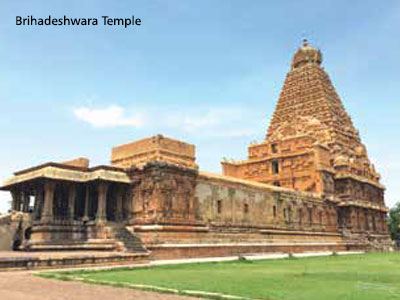 The Brihadeeshwarar temple has an awe-inspiring 226 ft tall srivimanam (central tower), which soars over the entrance gopuram and is visible from every corner of the town. The monolithic granite block which forms a cupola at the top weighs a massive 81.3 tonnes. The 107-paragraph inscription on the walls of the vimanam details the contribution of the greatest of the Chola monarchs, Raja Raja Chola 1 (985-1014) and of his sister Kundavai to the temple.
The Brihadeeshwarar temple has an awe-inspiring 226 ft tall srivimanam (central tower), which soars over the entrance gopuram and is visible from every corner of the town. The monolithic granite block which forms a cupola at the top weighs a massive 81.3 tonnes. The 107-paragraph inscription on the walls of the vimanam details the contribution of the greatest of the Chola monarchs, Raja Raja Chola 1 (985-1014) and of his sister Kundavai to the temple.
This imposing temple has several other distinguishing characteristics. Set in a two-storey sanctum the shivalingam (a form taken by Lord Shiva), the biggest in South India, is also called Peruvudaiyar or Rajarajeswaramudaiyar. A long prakaram surrounds the temple whose walls and pillared corridors abound in murals, shivalingams and nandis.
The Periya Nayaki and Subramanyar temples within the main complex were added during the Pandya period. Both the interior and exterior walls of the temple portray incidents from the lives of the Nayanmars, Bharatnatyam postures and manifestations of Lord Shiva. A monolithic Nandi (bull), 12 ft high and 20 ft long dating to the Nayak period is enshrined in its own mandapam.
Getting there. The nearest airport is Thiruchirappalli (58 km), connected by air to Chennai, Kochi, Colombo and Sharjah. Thanjavur is connected by rail to Trichy, Madurai, Chennai and other towns of Tamil Nadu. It is also well connected by road with most places in the south. It is 114 km from Chidambaram, 392 km from Kanyakumari, and 334 km from Chennai.
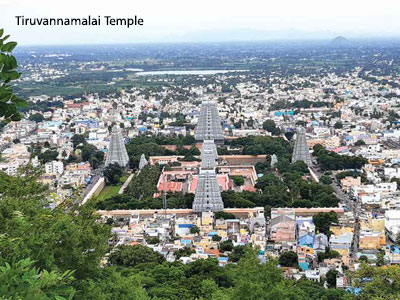 Accommodation. Top-end: Ideal River View Resort (Rs.4,604-4,703 per night), Hotel Parisutham (Rs.3,059-3,442). Mid-range: Hotel Sangam (Rs.2,999 onwards), Hotel Aalia Residency (Rs. 2016 onwards). Budget: Hotel Valli (Rs. 798 onwards), R. VE. R Residency (Rs. 540 onwards).
Accommodation. Top-end: Ideal River View Resort (Rs.4,604-4,703 per night), Hotel Parisutham (Rs.3,059-3,442). Mid-range: Hotel Sangam (Rs.2,999 onwards), Hotel Aalia Residency (Rs. 2016 onwards). Budget: Hotel Valli (Rs. 798 onwards), R. VE. R Residency (Rs. 540 onwards).
Excursions. There are numerous temples in and around Thanjavur that are worth visiting. Thirukandiyur (10 km) is noted for its Brahmasirikandeswaran and Harshavimochana Perumal temples. Kumbakonam (36 km), one of the most sacred places in the south and well known for the Masi Maham festival, hosts the Sarangapani, Kumbakeswarar, Nageswara and Ramaswamy temples. Swamimalai (32 km) has a fine temple atop a hill dedicated to Lord Muruga, which attracts many devotees.Thiruvaiyar (13 km) is the seat of saint Thyagaraja, father of Carnatic music who lived and attained samadhi here. Every year in January a music festival is staged here to honour him. The famous Gangaikondacholapuram (71 km), the beautiful Velankanni church (90 km) and Nagore (88 km) are other renowned pilgrim centres around Thanjavur.
Nataraja Temple, Chidambaram
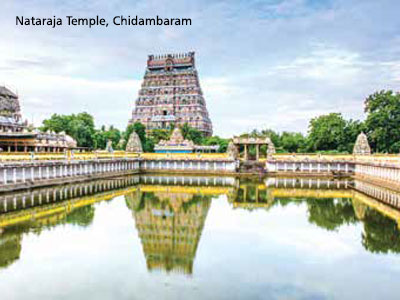 The seat of the celestial dancing Nataraja who performed the cosmic dance of bliss here, Chidambaram derived from the Tamil chit (mind) and ambaram (space), is one of the revered pancha (five) bhutasthalas in south India. Chidambaram is the akasasthalam (space), Kanchipuram is the prithvisthalam (earth), Tiruvanaikaval is the appusthalam (water), Kalahasti is the vayusthalam (air) and Tiruvannamalai is the thejosthalam (fire).
The seat of the celestial dancing Nataraja who performed the cosmic dance of bliss here, Chidambaram derived from the Tamil chit (mind) and ambaram (space), is one of the revered pancha (five) bhutasthalas in south India. Chidambaram is the akasasthalam (space), Kanchipuram is the prithvisthalam (earth), Tiruvanaikaval is the appusthalam (water), Kalahasti is the vayusthalam (air) and Tiruvannamalai is the thejosthalam (fire).
Legend has it that Lord Shiva came down to earth as Chidambaram to dance and oblige the saints living here but since goddess Kali was already in residence, a dispute arose between them. They mutually agreed that the winner in a dance competition would reside here. Shiva commenced with the thandava and Kali, the lasya. But Shiva bent the rules by lifting one leg high up which Kali could not do because of modesty. Thus Shiva became the lord of Chidambaram while Kali resides on the outskirts towards the north. The high-legged dance form of Lord Shiva immortalised by the dancing Nataraja bronze is known as oorthuvathandavam.
The awesome Nataraja temple — “pride of Chidambaram” — is built of granite and sprawls across 400 acres. Surrounded by massive walls with four tall gopurams the temple is a dance connoisseur’s and architect’s delight, showcasing 108 perfectly sculpted dance postures of the natya sastra in its four towers. It comprises five principal sabhas or great halls — the Kanaka sabha, Chit sabha, Nrityasabha, Deva sabha and Raja sabha.
The idol of Nataraja is enshrined in the Chit sabha fronting a black granite screen, which shields the akasa lingam in the main sanctum. Here, Lord Shiva is worshipped as a formless presence, which explains why the sanctum is empty except for golden garlands of vilva blooms. Five silver plated steps lead into the Chit sabha, representing the panchaksharamantram (five-alphabet prayer). The images of saints Vyagrapada and Patanjali who were blessed with the vision of Lord Shiva’s cosmic dance, are embossed on the doors. The sanctum of Sivakama Sundari lies to the left of the Nataraja sanctum.
A tour of the other sabhas is an equally enriching experience for art aficionados. The Kanaka sabha (with its gold-plated ceiling) is a site of devout worship. The Nrityasabha, richly sculpted in the form of a chariot drawn by horses, showcases various images of Nataraja in cosmic dance poses; the Deva sabha is a spacious hall for the celebration of important festivals and contains the images of the panchamurtis (five figures) — Somaskandar, Parvati, Vinayaka, Subramanya and Chandikeswara along with other deities. The spacious Raja sabha consists of a 1,000-pillared hall in the outermost prakaram. Every year in February-March classical dancers perform at the Natyanjali festival which starts on Mahashivaratri day and continues for five days. The festival attracts dance and music enthusiasts from around the world.
Getting there. The nearest airport is Trichy (174 km). Chidambaram is linked by rail and road to Chennai, Thanjavur, Trichy and other important towns.
Accommodation. Hotels in Chidambaram offer rudimentary facilities. Mid-range: Hotel Akshaya (Rs.2,284-2,475 per night), Hotel Saradha Ram (Rs.1,248-2,148).
Budget. VS Lodging (Rs.600 onwards), Meera Lodge (Rs.400 onwards).
Thiruvannamalai temple
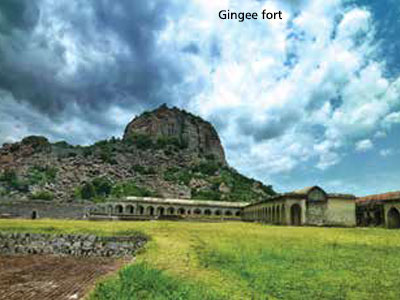 The Thiruvannamalai Temple in Thiruvannamalai district is dedicated to Lord Arunachaleswara and his consort, goddess Unnamalai. It enshrines Lord Shiva in his ‘fire’ form. Sited at the foot of a range of hills, the temple sprawls over 23 acres and is the venue of the famous karthigaidepam festival in December-January, when a leaping flame appears atop one of the hills. During the festival devotees throng here to worship in the temple lit with over 1,000 oil lamps.
The Thiruvannamalai Temple in Thiruvannamalai district is dedicated to Lord Arunachaleswara and his consort, goddess Unnamalai. It enshrines Lord Shiva in his ‘fire’ form. Sited at the foot of a range of hills, the temple sprawls over 23 acres and is the venue of the famous karthigaidepam festival in December-January, when a leaping flame appears atop one of the hills. During the festival devotees throng here to worship in the temple lit with over 1,000 oil lamps.
Two legends are associated with this historic temple — Lingodbhava and Ardhanarishwara. In the first, Lord Vishnu and Lord Brahma who prided themselves as supreme godheads set out to prove their supremacy by taking a test and failed miserably. Shiva manifested himself as a cosmic flame of light and proved his supremacy in the cosmic world. When they repented he assumed the form of a linga. In the second legend, Goddess Uma playfully covered Lord Siva’s eyes and all creation became dark. As repentance for her sin, Lord Shiva told her to go to Thiruvannamalai and perform penance so that she could take her place on the left side of his body. She obeyed his wish and once reconciled, they became known as ardhanarishwara (half woman half man).
Though the history of this ancient temple dates back to the 7th century, additions were made by several kings in differing periods. There are five prakarams and nine gopurams within the temple complex, of which the first two prakarams were built by the early Pandyan kings. In the 13th century, the Hoysala kings from Karnataka built the small shrines and prakarams in the temple. The tallest gopuram, 127 ft high and 102 ft wide, Rajagopuram was built by the Vijaynagar king Krishnadevaraya.
Getting there. The nearest airport is Chennai (170 km). Thiruvannamalai is well connected by rail to Katpadi and
Villupuram, which connect with Chennai and Bangalore (200 km). Bus services to Chennai, Pondicherry, Vellore, Chidambaram, Bangalore and Nagercoil are also available.
Accommodation. Top-end: Hotel Arunai Anantha (Rs.3,997 onwards per night). Mid-range: Hotel Arunachala (Rs.2,280-2,755) Budget: Sai Murugan Lodge (Rs.732 onwards)
Excursions. The Sri Ramana Maharishi Ashram (2 km) attracts thousands of devotees from around the world.
The Skanda ashram (3 km) is also worth a visit. The famous Gingee fort (35 km) in Villipuram district nestles on three hills and is enclosed by a huge rampart 60 ft thick, guarded by a moat 80 ft wide. Much of the early history of this 700-year-old fort is shrouded in mystery, as it changed many hands before it was annexed by the Vijayanagar kings. In 1750 Gingee was captured by the French and in 1761 surrendered to the British. The Sathanur dam (35 km) built on the river Ponnaiyar is a scenic picnic spot close by.
Also read: Karnataka composite tourism destination

















Add comment